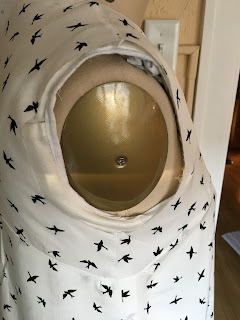This post was written months ago, but apparently, I forgot to publish it. I went back to look for it after writing about my most recent project on it. It's a bit late now, but Bernina 717 deserves to share her story.
She was listed on Craigslist in a different state. A Bernina 717 in a cabinet and reasonably priced, so I had to see if I could get her back to Chicago. The machine was up near Mankato, MN which is between the Twin Cities where my sisters live and Chicago. Ok, not really on the way, but for a Bernina a bit of a side trip could be made.
Originally, I was planning to be in the Twin Cities before Valentine's Day to meet my new niece. She turned out to not be in a rush and missed her due date by at least a week. So, I did not end up going to MN until about a month later. Mom went up after my niece was born to help out though and when she came home she was willing to make a detour through Rochester, MN on her way back to Illinois. The lady who was selling the machine had infinite patience and I really do appreciate her giving me time to sort out how to get the machine home. She even helped me look into the cost of shipping the machine when travel plans were up in the air.
The machine had a cabinet, foot control, and power cord, but there were no accessories or manual. I put the machine in the front room with a view out the window for awhile until I could clean her up and try her out.
 |
| In front of the sunny window |
Here is a close up of the machine before I cleaned her inside and out. The hand wheel shows wear, but most of the other scuffs and discoloring should clean up.
The first step was taking her out of the cabinet and then I took a look inside. While the machine did sew, clearly it was not running as smoothly as it could. There was quite a build-up of gunk on some of the gears. Q-tips and alcohol got it cleaned up, but it was a red substance caked on there that I hadn't seen before. Usually things turn brown, but this was a decidedly red jelly substance. Is there a grease or oil out there that is red colored?
 |
| Distinct red coloring isn't noticeable in this picture |
The zig-zag lever was frozen and I used heat and Tri-Flow to get is loosened up. The needle position piston was also stuck so I couldn't move the needle right-left-center, but that loosened up as well with heat.
 |
| The back side needed cleaning and the pressure foot lifter and spool pins had a bit of rust |
Here she is all cleaned up and back in the cabinet.
 |
| Almost looks brand new |
Has anyone reading this used a Bernina 717 before? Any comments, suggestions, warnings as I look for a project to try out on this machine?

















































